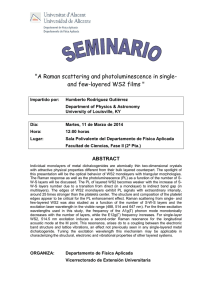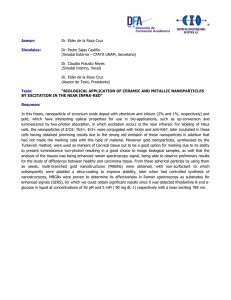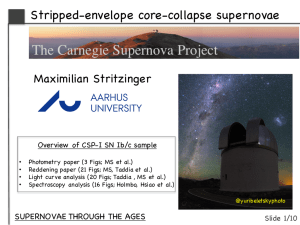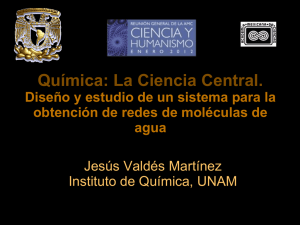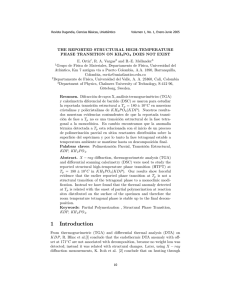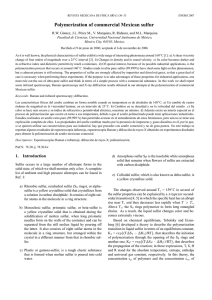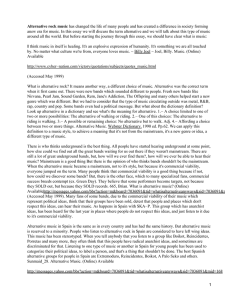Raman and structural studies on the high
Anuncio
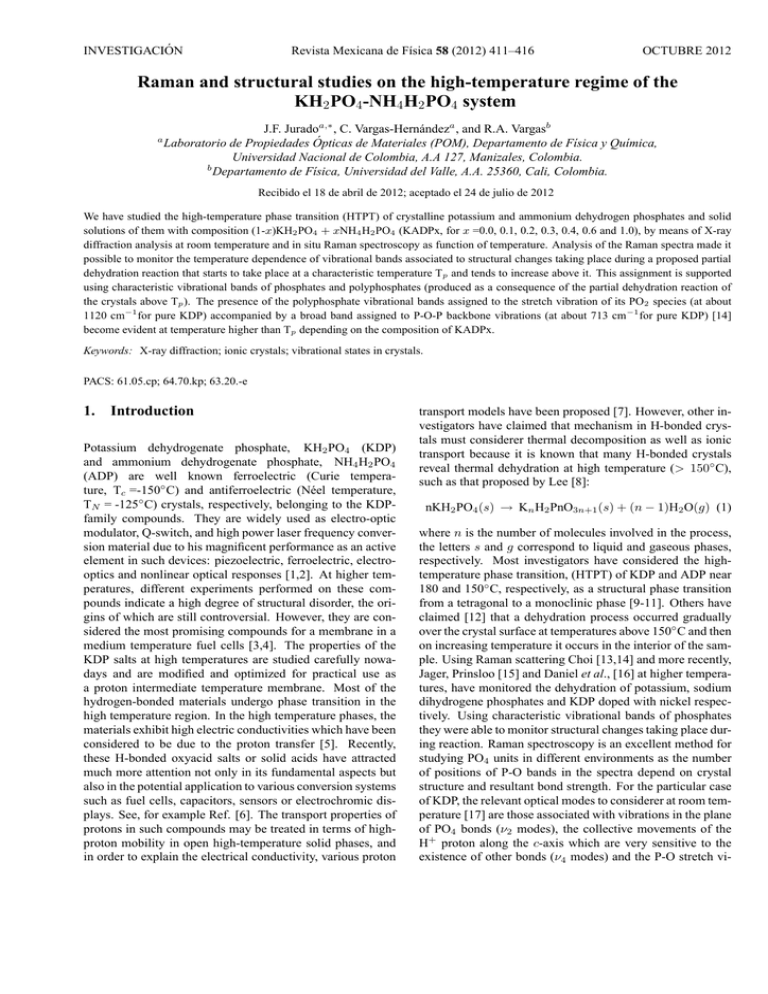
INVESTIGACIÓN
Revista Mexicana de Fı́sica 58 (2012) 411–416
OCTUBRE 2012
Raman and structural studies on the high-temperature regime of the
KH2 PO4 -NH4 H2 PO4 system
a
J.F. Juradoa,∗ , C. Vargas-Hernándeza , and R.A. Vargasb
Laboratorio de Propiedades Ópticas de Materiales (POM), Departamento de Fı́sica y Quı́mica,
Universidad Nacional de Colombia, A.A 127, Manizales, Colombia.
b
Departamento de Fı́sica, Universidad del Valle, A.A. 25360, Cali, Colombia.
Recibido el 18 de abril de 2012; aceptado el 24 de julio de 2012
We have studied the high-temperature phase transition (HTPT) of crystalline potassium and ammonium dehydrogen phosphates and solid
solutions of them with composition (1-x)KH2 PO4 + xNH4 H2 PO4 (KADPx, for x =0.0, 0.1, 0.2, 0.3, 0.4, 0.6 and 1.0), by means of X-ray
diffraction analysis at room temperature and in situ Raman spectroscopy as function of temperature. Analysis of the Raman spectra made it
possible to monitor the temperature dependence of vibrational bands associated to structural changes taking place during a proposed partial
dehydration reaction that starts to take place at a characteristic temperature Tp and tends to increase above it. This assignment is supported
using characteristic vibrational bands of phosphates and polyphosphates (produced as a consequence of the partial dehydration reaction of
the crystals above Tp ). The presence of the polyphosphate vibrational bands assigned to the stretch vibration of its PO2 species (at about
1120 cm−1 for pure KDP) accompanied by a broad band assigned to P-O-P backbone vibrations (at about 713 cm−1 for pure KDP) [14]
become evident at temperature higher than Tp depending on the composition of KADPx.
Keywords: X-ray diffraction; ionic crystals; vibrational states in crystals.
PACS: 61.05.cp; 64.70.kp; 63.20.-e
1.
Introduction
Potassium dehydrogenate phosphate, KH2 PO4 (KDP)
and ammonium dehydrogenate phosphate, NH4 H2 PO4
(ADP) are well known ferroelectric (Curie temperature, Tc =-150◦ C) and antiferroelectric (Néel temperature,
TN = -125◦ C) crystals, respectively, belonging to the KDPfamily compounds. They are widely used as electro-optic
modulator, Q-switch, and high power laser frequency conversion material due to his magnificent performance as an active
element in such devices: piezoelectric, ferroelectric, electrooptics and nonlinear optical responses [1,2]. At higher temperatures, different experiments performed on these compounds indicate a high degree of structural disorder, the origins of which are still controversial. However, they are considered the most promising compounds for a membrane in a
medium temperature fuel cells [3,4]. The properties of the
KDP salts at high temperatures are studied carefully nowadays and are modified and optimized for practical use as
a proton intermediate temperature membrane. Most of the
hydrogen-bonded materials undergo phase transition in the
high temperature region. In the high temperature phases, the
materials exhibit high electric conductivities which have been
considered to be due to the proton transfer [5]. Recently,
these H-bonded oxyacid salts or solid acids have attracted
much more attention not only in its fundamental aspects but
also in the potential application to various conversion systems
such as fuel cells, capacitors, sensors or electrochromic displays. See, for example Ref. [6]. The transport properties of
protons in such compounds may be treated in terms of highproton mobility in open high-temperature solid phases, and
in order to explain the electrical conductivity, various proton
transport models have been proposed [7]. However, other investigators have claimed that mechanism in H-bonded crystals must considerer thermal decomposition as well as ionic
transport because it is known that many H-bonded crystals
reveal thermal dehydration at high temperature (> 150◦ C),
such as that proposed by Lee [8]:
nKH2 PO4 (s) → Kn H2 PnO3n+1 (s) + (n − 1)H2 O(g) (1)
where n is the number of molecules involved in the process,
the letters s and g correspond to liquid and gaseous phases,
respectively. Most investigators have considered the hightemperature phase transition, (HTPT) of KDP and ADP near
180 and 150◦ C, respectively, as a structural phase transition
from a tetragonal to a monoclinic phase [9-11]. Others have
claimed [12] that a dehydration process occurred gradually
over the crystal surface at temperatures above 150◦ C and then
on increasing temperature it occurs in the interior of the sample. Using Raman scattering Choi [13,14] and more recently,
Jager, Prinsloo [15] and Daniel et al., [16] at higher temperatures, have monitored the dehydration of potassium, sodium
dihydrogene phosphates and KDP doped with nickel respectively. Using characteristic vibrational bands of phosphates
they were able to monitor structural changes taking place during reaction. Raman spectroscopy is an excellent method for
studying PO4 units in different environments as the number
of positions of P-O bands in the spectra depend on crystal
structure and resultant bond strength. For the particular case
of KDP, the relevant optical modes to considerer at room temperature [17] are those associated with vibrations in the plane
of PO4 bonds (ν2 modes), the collective movements of the
H+ proton along the c-axis which are very sensitive to the
existence of other bonds (ν4 modes) and the P-O stretch vi-
412
J.F. JURADO, C. VARGAS-HERNÁNDEZ, AND R.A. VARGAS
brations (ν1 modes). The ν3 modes correspond to antisymmetric and not well-defined vibrations. For ADP, there are
additional modes associated with N-H-O bonds.
In the present work, we have decided to study the binary
system (1-x)KH2 PO4 +xNH4 H2 PO4 (KADPx, for x=0.0,
0.1, 0.2, 0.3, 0.4, 0.6 and 1.0) by Raman spectroscopy to follow the evolution of the vibrational modes and to distinguish
between the phases at different temperatures. X-ray diffraction at room temperature was done on the samples with the
concentration prepared.
TABLE I. Variations of the lattice parameters and stress with concentration
KADPx
a (Å)
b (Å)
c (Å)
e(%)
x=0.0 7.4382±0.0051 7.4382±0.0051 6.9450±0.0313
x=0.1 7.4357±0.0003 7.4165±0.0051 6.7163±0.0285
11
x=0.2 7.4285±0.0003 7.4072±0.0017 6.8578±0.0107 9.1
x=0.3 7.4208±0.0004 7.4004±0.0006 6.9127±0.0167 8.4
x=0.4 7.4356±0.0005 7.4356±0.0005 6.9435±0.0383 8.0
x=0.6 7.4341±0.0004 7.4341±0.0004 6.9758±0.0650 7.6
2. Experimental Details
KDP and ADP powders commercially available (Panreac
Quı́mica SAU) were used as starting materials. Crystals of
(1-x)KH2 PO4 +xNH4 H2 PO4 (KADPx, for x=0.0, 0.1, 0.2,
0.3, 0.4, 0.6 and 1.0) were grown from aqueous solutions at
room temperature by low evaporation of the solvent. Transparent crystals with pyramidal geometry, average crystallite
size of 3×2×2 mm3 and preferential direction of growth
along {100} were obtained. X-ray diffraction at room temperature was performed with an Advance A8 Buker AXS
diffractrometer, with monochromatic radiation source CuKα
(1.5406 Å). Raman scattering measurements were carried out
with a LabRAM HR800 JobinYvon Horiba high-resolution
spectrometer, excited with the 473 nm line, exposure of 2 µm
diameter, in the spectral range from 150 to 4000 cm−1 .
The crystalline sample was located in a home-made microfurnace coupled to the micro-Raman instrument for in situ
Raman spectroscopy measurements as a function of temperature. The temperature was recorded with a type-K thermocouple located very close to the sample, the Raman spectra
were recorded at various isotherms in the temperature range
F IGURE 1. X-ray diffraction at room temperature of KADPxsystem for: x =0.0, 0.1, 0.2, 0.3, 0.4 and 0.6. For x > 0, only
the most intense peak (200) are shown for data analysis (see text).
The inset shows the dependence of the peak position and strain with
concentration. The dashed line is a guide to the eye.
from 25 to 288◦ C. The experimental temperature was maintained within ±0.5◦ C by the temperature-controlled microfurnace.
3.
3.1.
Results and Discussion
X-ray diffraction
The dependence of the lattice parameters on partial cation
substitution in the double salts KADPx (all of them with the
KDP tetragonal I42d structure) is shown in Fig. 1. The results are consistent with literature reports [19]. The cell parameters of the double salts (Table I) are comparable to those
of KDP, probably because the effective size of the substituting cations is comparable in the crystalline phase. This is so
because the effect of ammonium substitution by potassium
ions on changing the a and b parameters is negligible since
the crystals are primarily formed by phosphate units (PO4 )
linked together via strong hydrogen bonds. On other hand,
the parameter c is dependent on the radii of the both the constituent anions and cations. Table I also gives the stress values
as calculated for the c parameters for ADP according to the
expression [20]
F IGURE 2. Raman spectra at room temperature of KDP and ADP
crystalline compounds. The arrows indicate the location of the
modes in correspondence with Ref. [14] and [17].
Rev. Mex. Fis. 58 (2012) 411–416
RAMAN AND STRUCTURAL STUDIES ON THE HIGH-TEMPERATURE REGIME OF THE KH2 PO4 -NH4 H2 PO4 SYSTEM
413
(cexp − cADP )
× 100%
cADP
where cexp is the experimental value of the lattice parameter at
a given concentration and cADP the lattice parameter of ADP
without effort. When the bigger ammonium ions (1.42 Å)
substitute the smaller potassium ions (1.33 Å), both the Hbond length and strength around the central PO4 unit are consequently changed.
e=
3.2.
Raman spectra
The room temperature Raman spectra of KDP and ADP crystals with the laser beam incident on the {100} face are shown
in Fig. 2. In correspondence with the experimental geometric
arrangement of the crystals (i.e., x(zz)y) and the Raman data,
the various observed active modes of KDP and ADP were
assigned in accordance with Ref. [21]. Figure 3i shows
the
F IGURE 3. (i) Raman spectra of KADPx-crystals, for x=0.0, 0.1,
0.2, 0.3, 0.4, 0.6 and 1.0, at room temperature. The arrows indicate
two selected peaks I1 and I2 of the ADP spectrum for analysis of
the K+ /NH+
4 substitution in KADPx (see text). (ii) Variation of
peak positions of I1 and I2 and their intensities relationship I1 /I2 as
a function of the content of ADP at room temperature. The dashed
lines are guide for the eye.
F IGURE 4. Raman spectra of KDP crystal at different temperatures. The dashed circles mark the shifting of the bands with temperature, and are associated with possible changes in the vibrational
modes of the compound.
the room temperature Raman spectra of KADPx as the ADP
concentration increases. All spectra display one band at approximately 915 cm−1 (ν1 ) associated with the total symmetric breathing vibration of PO4 . The cationic substitution of
K+ by NH+
4 is evident by following the evolution of a localized mode at 1660 cm−1 which is characteristic of the ADP
tetragonal phase, as well as the displacement of the peaks denoted as I1 and I2 , respectively. The relative shift position of
the peaks I1 and I2 , is consistent with earlier reports by Choi
et al. [14,17]. From these two peaks intensity ratio I1 /I2 it
was estimated the K+ /NH+
4 substitution in the KADPx solid
solution (see Fig. 3ii).This behavior is consistent with X-ray
analysis (shown in the inset of Fig. 1). Figure 4 shows the
Raman results when the KDP crystal is heated gradually from
room temperature up to 285◦ C at atmospheric pressure, and
the Raman spectra are recorded in situ at different isotherms.
The spectra show clear changes in the vibrational modes of
the KDP crystal as a function of temperature, related to complete disappearance or presence of various bands, the shifts to
different wave numbers or broadening of others. In particular,
we want to emphasize the following changes: (a) Comparing
the spectrum recorded at 151◦ C to that at 177◦ C it is observed: (i) the almost complete extinction of the band located
at 189 cm−1 (ii) a shift in the band from 474 to 518 cm−1
and 915 to 901 cm−1 respectively, (iii) the presence of a new
band located at 1176 cm−1 . (b) Comparing the spectra at
204◦ Cand 235◦ Cit is evident: (i) the almost complete extinction of the bands 518 cm−1 and 1176 cm−1 (ii), the presence
of a new band at 713 cm−1 , and (iii) a shift of the band from
901 to 926 cm−1 . This latest displacement is reversible, as
long as the crystal is cycled about 235◦ C for less than 10◦ C
and during less than 5 minutes of temperature cycling. When
the temperature is increased from 243 to 285◦ C the spectra
show: (i) The almost disappearance of the band located at
365 cm−1 , (ii) the presence of the band located at 519 cm−1 ,
(iii) band shift to lower wave number from 926 to 900 cm−1 ,
(iv) band broadening is evident at around 1120 cm−1 .
Rev. Mex. Fis. 58 (2012) 411–416
414
J.F. JURADO, C. VARGAS-HERNÁNDEZ, AND R.A. VARGAS
F IGURE 6. Raman spectra of the KADP0.1 crystal at different temperatures. The arrows indicate the evolution of the selected modes
with temperature. The modes are assigned in correspondence with
Ref. [14] and [17].
F IGURE 5. i) Raman spectra of ADP-crystal at different temperatures. The arrows indicate the modes associated with stretch
vibrations of PO4 and N-H-O and O-H-O species, respectively.
ii) Temperature dependence of FWHM for the peaks located at:
a) 922 cm−1 , b) 1660 cm−1 and c) 3157 cm−1 of the ADP crystal. The arrow indicates the transition region that shows an abrupt
change of FWHM. The dashed lines are a guide to the eye.
The shift to higher wave number, the broadening and final
disappearance of the 189 cm−1 band as well as the overlapping the bands around 300 and 600 cm−1 , show that the KDP
crystal continuously adopts a new structural configuration as
the temperature increases, that is to say that the hydrogen
bonds or the P(OH)4 (in KDP, each PO4 tetrahedron is hydrogen bonded to four others) adopting new configuration due to
their thermal softening. In other words, the thermal softening
of the H-bonds leads to a variation in the number and position of the P-O bands in the spectra, depending of the crystal
structure and resultant bond strength at a given temperature.
The change environment of the PO4 on increasing temperature is also evident by the shift and broadening of the ν1 band
(located at 915 cm−1 at room temperature). The appearance
of a new phase at high temperatures is justified by the presence at 285◦ C of the νs (P-O-P) and νs (O–P-O-) modes,
located at 713 and 1120 cm−1 , assigned to the stretch vibration of the PO2 species and the P-O-P backbone vibration
of the polyphosphate formed during the dehydration reaction
suggested by Lee [8]. The gradual change observed in the Raman spectra of KDP crystal as the temperature is increased
from room temperature support the idea that the high temperature phenomena in this compound are effects of partial
thermal decomposition set in around 180◦ Cas it is evident
from other studies [22]. The results are consistent with a coexistence of phases above this temperature (KDP and partial
dimmers K2 H2 P2 O7 or polymers Kn H2 Pn O3n+1 (n > 2,
according to equation), whose mass ratio depends on temperature and the thermal treatment and the water vapor pressure
of the surrounding atmosphere. Figure 5i shows the Raman
results when the ADP crystal with the same size as the KDP
is heated gradually from room temperature up to 162◦ Cat atmospheric pressure, and the Raman spectra were recorded in
situ at different isotherms. Raman active modes are located
at: 183, 341, 475, 570, 922, 1122, 1303, 1436, 1660, 2370,
2884, 3157 cm−1 . As the temperature is increased there is
no appreciable variation in the number and positions of the
bands. These results indicate that the vibrations associated
with the crystal structure and the molecular modes of vibrations of the ADP crystal, remains identical up to 153◦ C. Figure 5ii shows a qualitative analysis of the temperature dependence of peak width (as measured by its FWHM) of the
three main peaks (see Fig. 5i), located at 922(a), 1660(b) and
3157(c) cm−1 which are assigned to the symmetric stretching vibrations of PO4 , N-H–O and O-H–O bonds, respectively. The results indicate that there is a distortional effect
in the crystal with increasing temperature. The first (a) and
second (b) peaks evolution indicates a decreasing distortion,
while the third one (c) shows instead an increasing distortion.
These tendency are maintained up to about 145◦ C, but above
this temperature there is an abrupt downwards change. This
Rev. Mex. Fis. 58 (2012) 411–416
RAMAN AND STRUCTURAL STUDIES ON THE HIGH-TEMPERATURE REGIME OF THE KH2 PO4 -NH4 H2 PO4 SYSTEM
F IGURE 7. Raman spectra of KADPx crystals with x=0.0, 0.1, 0.2,
0.3, 0.4, 0.6, and 1.0, at temperature of 151◦ C. The compounds retain the vibrational bands that are present in the low temperature
region.
This change is more pronounced for the (b) peak showing
that the vibrations associated with the N-H–O bond strength
are more sensible with increasing temperature than those of
the PO4 and the O-H–O bonds. The steep variation of the
peak width assigned to the N-H–O stretch vibrations observed above 145◦ Cis probably responsible for the high conductivity that ADP shows above 154◦ C [23].
Figure 6 shows Raman spectra of the KADPx (x=0.1)
recorded in situ at different isotherms between room temperature and 258◦ C. The spectra show clear changes in the vibrational patterns of the crystal as a function of temperature.
(a) The spectra recorded below 155◦ C show no significant
changes and are similar to those observed in the KDP spectra
in the same temperature range (Fig. 4). (b) In going from
the spectrum recorded at 155◦ C to that at 193◦ C, is more evident the presence of the bands at 522 cm−1 and 665 cm−1 ,
the appearance of a new band located at 713 cm−1 , and a
shift of the peak position from 915 cm−1 to 910 cm−1 . (c)
From 206 to 243◦ C, the spectra show the almost complete
extinction of the band located at 183 cm−1 , the overlap of
the bands at about 473 and 550 cm−1 and it is more evident a
shift position and broadening of the band at about 901 cm−1 ,
(d) from 243 to 258◦ C, the presence of new bands at about
966 and 1097 cm−1 are evident. From the KADPx (x=0.1)
Raman results as a function of temperature, we can conclude
that the vibrational modes of KADP0.1 are the same as those
of the KDP crystal, such that the effects of this dilute substitution of K+ by NH+
4 ions on the KDP characteristic bands
are not transcendental. The Raman data for concentrations
x > 0.1 showed similar patterns with increasing temperature
to those reported for x=0.1, except that the temperatures at
which vibrational bands change decrease as the concentration increases.
415
F IGURE 8. Raman spectra of KADPx crystals with x= 0.1, 0.2, 0.3,
0.4 and 0.6 above 170◦ C. The isotherm chosen for each concentration depend on the onset temperature where the partial dehydration
reaction [8] starts to occur (see text).
The Fig. 7 shows Raman scattering data of the KADPx
compounds for temperatures close to 151◦ C, clearly indicating that each compound maintains the vibrational arrangement adopted in the low temperature region (see Fig. 3i).
The Fig. 8 shows the Raman data for the KADPx at a
fixed temperatures above 170◦ C, depending on the concentration x and it is associated with a characteristic temperature
where the corresponding spectrum pattern recorded is quite
different from that observed at low temperatures. Comparing this characteristic temperatures for each concentration x,
we conclude that it decreases as the concentration increases.
This temperature is 173◦ C for x=0.6, close to that of pure
ADP, while that for the concentration x=0.1 is about 206◦ C,
close to that of pure KDP.
4.
Conclusions
The appearance of high proton conductivity in both KDP and
ADP near 180◦ C and 150◦ C respectively, have been considered by most of the investigators as a structural phase transition from a tetragonal to a monoclinic phase. On the basis of our study in KADPx double salts, using in situ Raman spectroscopy, we suggest that the high conductivity in
the high temperature phase is a consequence chemical dehydration process in the crystals. X-ray diffraction data analysis at room temperature verified the substitution of the K+
by NH+
4 ions in the KADPx combinations for all concentration x with a common crystallographic tetragonal phase. The
composition of the KADPx solid solution is also verified by
analysis of the Raman spectra. Contrary to those cases for
dihydrophosphate salts in which the effective size of the introduced cations is significant different, as for sodium, rubidium and cesium [24] the substitution of ammonium by potassium does not alter the cell parameters appreciably. However,
when a KADPx crystal is heated stepwise in a continuous and
progressive thermalization time of 10 min. in each isotherm,
Rev. Mex. Fis. 58 (2012) 411–416
416
J.F. JURADO, C. VARGAS-HERNÁNDEZ, AND R.A. VARGAS
Raman data verified that the compound adopts new vibrational patterns similar to those presented by KDP-crystal.
Bands changes such as complete disappearance or presence
of various bands, the shifts to different wave numbers or
broadening of others are observed at temperature higher than
about 180◦ C, depending on the x concentration. The thermal
softening of the H-bonds leads to a variation in the number
and position of the P-O bands in the spectra, depending of
the crystal structure and resultant bond strength at a given
temperature. The change environment of the PO4 on increasing temperature is also evident by the shift and broadening
of the ν1 band (located at about 900 cm−1 at room temperature for all concentration). The appearance of a new phase at
high temperatures is justified by the presence at higher temperatures of new modes assigned to the stretch vibration of
the PO2 species and the P-O-P backbone vibration of the
polyphosphate formed during the dehydration reaction sug-
gested by Lee [8]. Thus, the results are consistent with a
coexistence of phases at temperatures above 180◦ C temperature, a dominant low-temperature tetragonal phase and a partial polyphosphate phase, whose mass ratio depends on temperature and the thermal treatment time and the water vapor
pressure of the surrounding atmosphere. In summary, our
findings support the view of those investigators that claim
that the high conductivity shown by the KADPx double salts
above 180◦ C is a consequence of dehydration of the crystals
instead of being related to polymorphic transitions as suggested by others.
∗. Author to whom correspondence should be addressed: [email protected]
12. R.H. Chen, Chen-Chieh Yen, C.S. Shern, and T. Fukami, Solid
State Ionics 177 (2006) 2857-2864
1. P. Kumaresan, S. Moorthy Babu, and P.M Anbarasan, J. Crystal
Growth 310 (2008) 1999-2004.
2. Ferroelectrics, special issue on KH2PO4-type ferro- and antiferroelectrics 71-72 (1987)
3. D.A. Boysen, T. Uda, C.R.I. Chisholm, and S.M. Haile, Science
303 (2004) 68-70.
Acknowledgements
The authors wish to acknowledge the support of DIMA (Dirección de investigación, Universidad Nacional de Colombia,
Sede Manizales) to research project.
13. B.-K. Choi, J. Phys. Chem. Solids 56 (1995) 1023-1030
14. B.-K. Choi, and J. Korean, Phys. Soci. 32 (1998) s515-s517
15. H.-J- de Jager, and L.C. Prinsloo, Thermochimica Acta 376
(2001) 187-196.
16. D.P. Pereira et al., Solid State Commun. 152 (2012) 1023-1026
4. T. Uda and S.M. Haile, Electrochem. Solid State Lett. 8 (2005)
A245-A246.
17. Y. Kawahata, and Y. Tomina, Solid State Commun. 145 (2008)
218-222
5. M. Royle, J. Chao, and S.W. Martin, J. Non-Crys. Solids 279
(2001) 97-109
18. D. Xu, and Dongfeng Xue, J. Crys. Growth 286 (2006) 108-113
6. Zikun Li, and Tongbor Tang, Solid State Ionics 211 (2012) 3441
7. Y. Imry, I. Pelah and E.J. Wiener, J. Chem Phys. 43 (1965)
2332-2340, A.I. Baranov, V.P. Khiznichenko and Na. A. Shuvalov, ferroelectrics 100 (1989) 135-141
19. J. A. Subramony, S. Lovell, and B. Kahk, Chem. Mate. 10
(1998) 2053-2057, J. A. Subramony, B. J. Marquart, J. W.
Macklin, and Bart Kahr, Chem. Matter. 11 (1999) 1312-1316.
20. W.H. Baur, Acta Crystallographic B 29 (1973) 2726-2731
8. K.E. Lee, J. Phys. Chem. Solids 57 (1996) 333-342
21. G. W. Lu, X. Sun, Crys. Res. Technol. 37 (2002) 93-99, G. Lu,
C. Li, W. Wang, Z. Wang, J. Guan, H. Xia, Mater. Science and
Eng. B 116 (2005) 47-53
9. R. Blinc, V. Dimic, G. Lahaynar, J. Stepisnik, S. Zumer, and N.
Vene, J. Chem. Phys. 49 (1968) 4996-5000.
22. E. Ortiz, R.A. Vargas and B.-E. Mellander, J. Phys Chem.
Solids 59 (1998) 305-310
10. J.Y. Nicholson and J.F. Soest, J. Chem. Phys. 60 (1974) 715716.
23. E. Torijano, R.A Vargas, J.E. Diosa, R. Cataño and B.-E. Mellander, Solid State Ionics 136-137 (2000) 979-984
11. R. S. Viswanath, and P. J. Miller, Solid State Commun. 29
(1979) 163-166.
24. V.V. Martsinkevich, and V.G. Ponomareva, Solid State Ioncs.
(2012), doi:10.1016/j.ssi.2012.04.016(In press)
Rev. Mex. Fis. 58 (2012) 411–416
